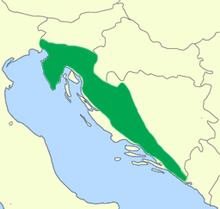Our website is made possible by displaying online advertisements to our visitors.
Please consider supporting us by disabling your ad blocker.
Olm
| Olm | |
|---|---|

| |
| Olms in Postojna Cave, Slovenia | |
| Scientific classification | |
| Domain: | Eukaryota |
| Kingdom: | Animalia |
| Phylum: | Chordata |
| Class: | Amphibia |
| Order: | Urodela |
| Family: | Proteidae |
| Genus: | Proteus Laurenti, 1768 |
| Species: | P. anguinus
|
| Binomial name | |
| Proteus anguinus Laurenti, 1768
| |
| Subspecies | |

| |
| Native range (pictured: northeastern coast of Adriatic Sea).[a] | |
The olm (German: [ɔlm] ⓘ) or proteus (Proteus anguinus) is an aquatic salamander which is the only species in the genus Proteus of the family Proteidae[2] and the only exclusively cave-dwelling chordate species found in Europe; the family's other extant genus is Necturus. In contrast to most amphibians, it is entirely aquatic, eating, sleeping, and breeding underwater. Living in caves found in the Dinaric Alps, it is endemic to the waters that flow underground through the extensive limestone bedrock of the karst of Central and Southeastern Europe in the basin of the Soča River (Italian: Isonzo) near Trieste, Italy, southern Slovenia, southwestern Croatia, and Bosnia and Herzegovina.[3] Introduced populations are found near Vicenza, Italy, and Kranj, Slovenia.[4] It was first mentioned in 1689 by the local naturalist Valvasor in his Glory of the Duchy of Carniola, who reported that, after heavy rains, the olms were washed up from the underground waters and were believed by local people to be a cave dragon's offspring.
This cave salamander is most notable for its adaptations to a life of complete darkness in its underground habitat. The olm's eyes are undeveloped, leaving it blind, while its other senses, particularly those of smell and hearing, are acutely developed. Most populations also lack any pigmentation in their skin. The olm has three toes on its forelimbs, but only two toes on its hind feet. It exhibits neoteny, retaining larval characteristics like external gills into adulthood,[5] like some American amphibians, the axolotl and the mudpuppies (Necturus).
- ^ a b IUCN SSC Amphibian Specialist Group (2022). "Proteus anguinus". IUCN Red List of Threatened Species. 2022: e.T18377A89698593. doi:10.2305/IUCN.UK.2022-2.RLTS.T18377A89698593.en. Retrieved 6 August 2023.
- ^ Frost, Darrel R. (2023) [1998]. "Proteus Laurenti, 1768". Amphibian Species of the World. American Museum of Natural History. Retrieved 19 March 2023.
- ^ Sket, Boris (1997). "Distribution of Proteus (Amphibia: Urodela: Proteidae) and its possible explanation". Journal of Biogeography. 24 (3): 263–280. Bibcode:1997JBiog..24..263S. doi:10.1046/j.1365-2699.1997.00103.x. S2CID 84308933.
- ^ Bulog, Boris; van der Meijden, Arie (26 December 1999). "Proteus anguinus". AmphibiaWeb. Retrieved 27 January 2014.
- ^ Burnie D.; Wilson D.E., eds. (2001). Animal. London: DK. pp. 61, 435. ISBN 0-7894-7764-5.
Cite error: There are <ref group=lower-alpha> tags or {{efn}} templates on this page, but the references will not show without a {{reflist|group=lower-alpha}} template or {{notelist}} template (see the help page).
Previous Page Next Page



